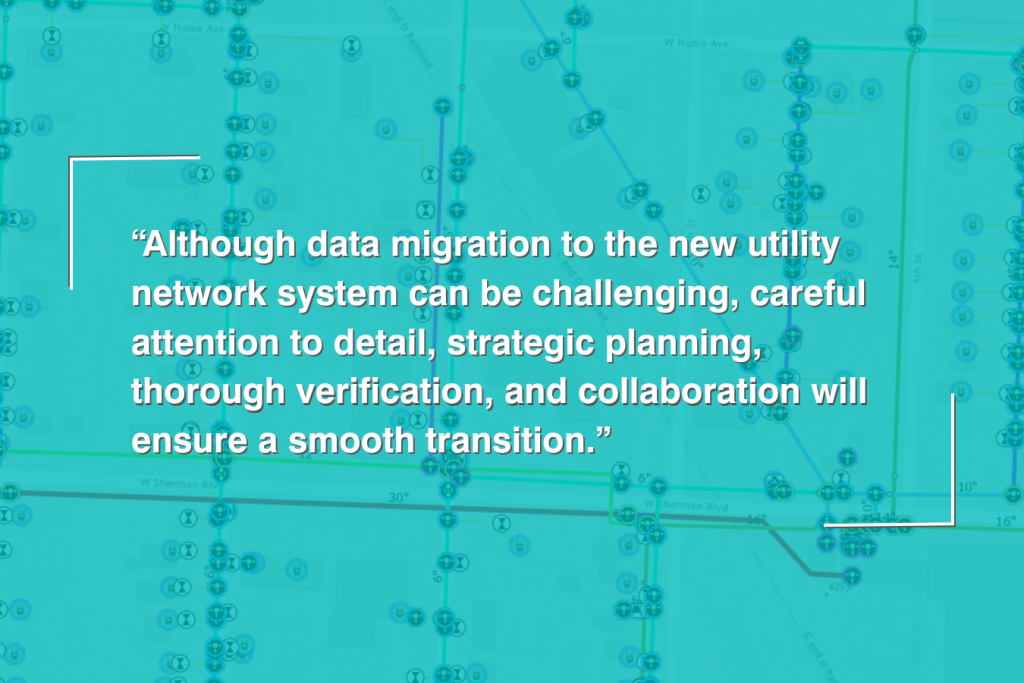
From Geometric Network to Utility Network: The Data Migration Process
As we approach Esri’s ArcMap retirement and wave goodbye to its geometric network, municipalities and corporations alike must start planning their data transition to Esri’s new utility network system. This new system, hosted by Esri’s ArcGIS Pro, brings major advantages while avoiding the transition will become highly consequential.
The new utility network system has standardized alignment, ensuring Esri can support continuous functionality improvement. This will provide enhanced data modeling, improved network tracing, better performance with large datasets, and real-time data integration within IoT devices. The system is built to ensure that everything is linked correctly and validated, giving users more reliability than the old geometric network, which offered more variability in data mapping causing more challenges for Esri to complete updates across the board.
Although data will still be accessible after ArcMap’s retirement, advanced editing and support will be significantly limited, making the old geometric network system increasingly inefficient.
Migrating the data is no easy feat. Several steps and thorough attention to detail must be taken throughout the phases to ensure the transition is completed well.
Phase One: Investigation
Data Assessment and Alignment
First and foremost, the current data on hand is reviewed to identify assets that need corrections by using specialized geoprocessing tools, topology rules, and data validation techniques. Some corrections may include reconnecting orphaned assets, standardizing attribute values, removing/resolving duplicate features, or flagging information for further investigation. This ensures the migration is smooth and avoids confusion when interpreting the data.
After cleaning, GIS experts identify what data is ready to transfer and where more details are needed. If more information on the infrastructure assets is needed, the transition to the utility network may be put on hold while the client gathers the missing details.
Data Preparation
Next, the team prepares the data to load into the utility network’s new configurations. Preparation requires classifying all data from the geometric network and matching it to the appropriate domains in the utility network.
Because the geometric network’s flexibility allowed variable data, some assets may not fit into the new alignment properly. In this case, data can still be migrated; it just won’t interact with other datasets in the utility network.
Migration Strategy Development
With a comprehensive picture of the current data, the team works closely with the client to strategize the transition. Coordinating with the client to understand their operational needs, team capabilities, and resources ensures that not only does the transition run smoothly but that the system is effective long-term.
Phase Two: Development and Deployment
Establishing the Utility Network
The team builds the utility network by configuring network rules, associations, and connectivity models, based on the client’s needs. Throughout the building process, the team performs rigorous testing to identify errors and validate network topology.
Data Migration
Once the data is cleaned and the utility network is established, GIS professionals transfer it to the new network. Extreme attention to detail is critical to ensure the data’s quality, consistency, and accuracy are maintained throughout the transition.
Program Validation
After the initial migration, the utility network is packaged for review for the client. At this point, it’s crucial for the client and the migration team to collaborate, identify any weaknesses, and ensure the network meets operational expectations. Any issues that may arise are worked through and resolved.
Deploying the Utility Network
Once validated, the GIS team deploys the utility network by configuring the dataset within the ArcGIS Enterprise geodatabase. This means the network transitions from a development environment to a production setting where it’s accessible to end-users. The utility network can also be published as a service to Portal, a component of ArcGIS that allows you to share geographic information with other users, allowing for broader collaboration with the client’s existing GIS platforms and asset management systems. Throughout this step, diligent testing is performed to validate data integrity, network tracing capabilities, and integration with other systems.
Post-deployment, ongoing monitoring, and maintenance are essential to address any issues, optimize performance, and ensure the utility network remains a reliable and effective tool for managing infrastructure.
Onboarding
The next step is to help the data owner learn the new system, if necessary. Depending on the owner’s level of expertise and capacity, the transition team can provide training to ensure the new system fulfills the client’s needs, and the owner can maintain it effectively.
Training, standard operating procedures, and documentation all help the owner successfully onboard with their new system.
Although data migration to the new utility network system can be challenging, careful attention to detail, strategic planning, thorough verification, and collaboration will ensure a smooth transition. This short-term stress of data migration has high long-term rewards. Not only does this upgrade improve network functionality, but it also prevents the system from becoming outdated and immutable.
With a highly experienced geometric network to utility network migration team, Metro Consulting Associates (MCA) can serve as a trusted and reliable resource to help clients make the transition. Our team provides big-picture thinking, industry best practices, and access to in-house civil engineering subject matter experts to tailor high-quality solutions.
Interested in starting the data migration process? Contact our team today!

Stay connected!
Subscribe to News + Ideas

